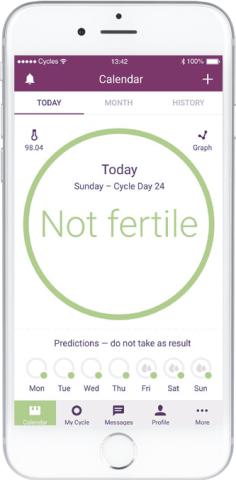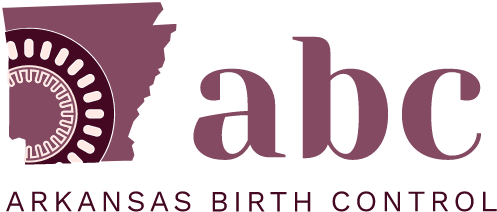Fertility awareness

Basic Info & FAQs
Fertility awareness-based methods—or natural family planning—are all about tracking your menstrual cycle to determine the days that you can get pregnant. The tricky part is actually knowing when those days are. To do that, you’ll need to pay very close attention to your body and its patterns. Here we list all the different ways you can monitor your day-to-day fertility.

If your menstrual cycle is between 26 and 32 days long, you can use this method to record your periods and determine when you can’t get pregnant.


This is another method where you observe cervical secretions to see when you’re fertile.


Your body secretes a distinct kind of goo when you’re most fertile. This method is all about observing your cervical mucus.


Use this method to chart your body temperature every single morning to determine whether or not you’re ovulating.


There are many signs that communicate when you’re fertile and this method tracks several of them at once, including how open your cervix feels.


Breastfeeding naturally suppresses fertility. This method works if you’ve just had a baby and are breastfeeding in a very specific way.

You want to get to know your body better
In addition to using Fertility Awareness as birth control, tracking your period can be a great way to get to know your body better, notice changes, and understand your cycle.
You wouldn’t mind getting pregnant
Failure rates are kinda high if not used correctly—so if getting pregnant would be disastrous for you and you’re not a total pro at fertility awareness, choose another method or use a backup like condoms while you’re getting the hang of it.
Total self-discipline
Both you and your partner need to be completely down with the program. You also need to know your body really well.
You’re okay with having a time-out from sex or using another method
If you’re not totally cool with taking a break from sex or using another non-hormonal method during your fertile time every month, fertility awareness-based methods aren’t for you.
You want a method with no side effects
Many people who use this method want something that doesn’t affect their bodies.
No prescription necessary
If you don’t want to use hormones, this is one option.
What does it cost?
Fertility Awareness-based methods—and tracking your body’s natural rhythm—take time and commitment, but they don’t cost a lot.
Prices:
- Thermometer: You can get one in the $10 range at any grocery, drug, or super-store—just make sure it reads to the tenth decimal place. You can also look into fertility tracking systems like Wink by Kindara, which is currently on pre-order for $79.
- Fertility Awareness Chart: Free download one chart here or check out this chart here.
- CycleBeads: This is a color-coded string of beads that represents the days of a woman’s cycle and helps her use the Standard Days Method correctly. Available online in regular and deluxe versions, ranging from $10-$25.
- Classes: Free up to $25-100+ per hour depending on where you go. Ask your health care provider or local health center if they know of qualified instructors, or check out the Fertility Awareness Center to find out about workshops in your area. (The center also offers instruction by phone, for a fee.) Some church-based organizations offer free classes, but they may require you to be married or engaged and want you to skip sex (rather than use another method) during your fertile times.
- Barrier Method: Depends on what method you choose (you’ll need this only if you choose to have sex during your fertile time of the month)
How do I use it?
Fertility awareness-based methods come down to this: Track your menstrual cycles and don’t have sex on the days that you can get pregnant; if you do have sex on those days, use an alternate method, like a condom—male or female—or diaphragm.
There are several different methods you can use to track your cycle and ideally you’ll use a combination of them to help with accuracy and success. They all involve observing changes in your body and calculating where you’re at in your menstrual cycle. This takes effort and commitment, so before you decide this is the method for you, be sure you really understand what you’ll need to do. Be prepared not to have sex for at least seven days out of every month. And if you do knock boots on your fertile days, have backup birth control on hand.
Standard Days Method
In order for this one to work for you, your menstrual cycle must be between 26 and 32 days long. This method incorporates CycleBeads, a handy string of colored beads that help you mark off the days of your menstrual cycle and track your fertility. Get more info about the standard days method here.
To get the hang of it, check out the Fertility Awareness Center. It has lots of information including where to find workshops in your area. They can even coach you on this over the phone.
TwoDay Method
Every day you’ll check to see if you have any cervical secretions. If you notice secretions of any type—today or yesterday—you’ll considers yourself fertile. That means no sex or using an alternative form of birth control if you notice any of your body’s natural goo.
Cervical Mucus Method
Ready to check your goo? This involves monitoring changes in your cervical mucus on a daily basis. This idea is that you can get pregnant from the onset of your secretions (when your goo is clear, stretchy, slippery, and wet) until 3 days after it stops. Best when used with Symptothermal Method or Standard Days method.
Body Basal Temperature Method (BBT)
You’ll take your temperature every morning before you get out of bed and write it down on a fertility awareness chart. Download one downloadable chart here or check out another version here. Best when used with Symptothermal Method or Standard Days Method.
Symptothermal Method
This method predicts fertility by combining more than one of the other Fertility awareness-based methods, most often the Body Basal Temperature Method and Cervical Mucus Method. Temperature Method and Cervical Mucus Method. Get more information about the symptothermal method here.
There are entire classes you and your partner can take to learn how to use this one, so we’re not going to go into the details here. Churches teach some classes, healthcare professionals teach others.
Lactational Amenhorrea Method
Breastfeeding can be used as a family planning method up to 6 months after having a baby. For this to work, you have to meet all three of the following criteria:
- No menstrual bleeding since your baby was born.
- You only breastfeed your baby (no other foods or liquids given).
- You feed your baby at least every 4 hours during the day and every 6 hours during the night.
If you are interested in LAM, read more about it here.
The good & the bad
The Positive
- Doesn’t cost a thing—except for the price of a basal thermometer or CycleBeads
- No prescription necessary
- No hormones added to your body
- No worries about side effects (other than the possibility of getting pregnant)
- Helps you learn more about your body and how it works
The Negative
- Takes planning, record-keeping, and self-control
- Requires abstinence (or use of an alternate method) for at least a week per cycle
- Both partners need to participate 100%
- The Calendar Method and the Standard Days Method don’t work for women with irregular periods
- Not something you should try if you’ve just gone off a hormonal method, because the hormones effect your cycle (you’ll need to use a non-hormonal method while you’re learning to track your cycle)
- Hard to stick to the plan if you’re drunk

